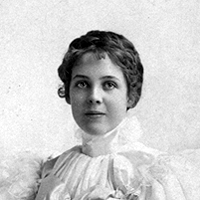Success Starts Here
Your gateway to the Library Catalog, Digital Items, Library Website search results, and more simultaneously!
Your gateway to the Library Catalog, Digital Items, Library Website search results, and more simultaneously!


Louise Richards Farnsworth was born in Salt Lake City, Utah in 1878. She painted Utah landscapes in brilliant fauvist style. She died in Salt Lake City in 1969.
From 1898 to 1900, she studied in New York at the Art Students League where her instructors were Kenyon Cox and Joseph De Camp. She later studied in Paris where her work was exhibited in the Salon in 1904. Although she frequently exhibited outside Utah, she maintained a studio in Salt Lake City until 1960.
Capitol from North Salt Lake (1935), Hay Stacks (1935), and Springtime (1935) are examples of her work. In 1934, an exhibition of her work, 52 oils of mountain scenes from Utah to Alaska, was exhibited at the Montross Gallery in New York. The Stendahl Gallery in Los Angeles exhibited 20 of her mountain landscapes. The Springville Art Museum includes her work in its permanent collection.
Biography adapted from Springville Museum of Art.
Utah native Louise R. Farnsworth was born in 1878 to Joseph and Louise Richards. She grew up in Salt Lake City, Utah, but received much of her artistic training in Paris and at the Art Student's League in New York. Her cousin, Utah artist Lee Greene Richards, also greatly influenced Farnsworth's artistic development through his use of bright color and loose, free application of paint.
A Figurative-Expressionist, Farnsworth's own investigation of brilliant, fauvist color brought her significant success in Paris, where her work was admitted into the Paris Salon. This honor, while prestigious in the International Art World, did not assure her success in Utah. In fact, in her native state, she met with less than overwhelming appreciation. One of the possible reasons for this negative reception is that in Utah, as in much of the United States, art was generally viewed as a man's territory. It was quite uncommon for a woman from Utah to study art at all, let alone for her to travel to Paris to do so.
Additionally, Farnsworth took a non-traditional approach to painting. She portrayed Utah landscapes in a passionate, bright expressionistic way she had gleaned from her cousin as well as from her studies in Paris. As Edward Allen Jewell of the New York Times stated, “Farnsworth has very definitely a point of view of her own. Here is no facile naturalism, sugared with suspicious allurements of the studio.“ This unique approach was a surprise to many of her fellow Utahns who had been raised on the gentler, impressionistic works of J.T. Harwood, John Hafen, and Edwin Evans.
Louise Farnsworth never put on a major exhibit in Utah or really associated with any other Utah artists with the exception of her cousin Lee Greene Richards. In fact, she came to isolate herself from those from whom she received little approval. According to the artist Ted Wassmer, whose wife Judy was related to Farnsworth, Louise turned into an embittered recluse who was reluctant to show her work in Utah. She found more acceptance in New York, where she had her first solo exhibition in 1934 at the Montross Gallery. Another solo exhibition of 39 pastel landscapes followed at the same gallery in 1938.
It is ironic that Farnsworth's paintings were, on the whole, unappreciated by the Utah art world, for Carlyle Burrows, art critic for the New York Herald Tribune said of her work, “The directness and vigor with which Louise Richards Farnsworth paints her Rocky Mountain landscapes fits well the spirit of the region. Several canvases show particularly good authority in handling, and strong, earthy, colors.“ Burrows also credited her with avoiding “ . . The pictureqesness of the grand vistas. . .,“ and remarked on her focus on “ . . The simplicity of the mountain masses. . . .“ Richard Oman, of the L.D.S. Museum of Church History and Art, also points out that Farnsworth's “ . . . mountain masses prove sufficiently interesting in themselves. . . . Her work has a freedom of brush that takes on a life apart from the scene being depicted. The texture of paint and brilliance of color take on a unique life of their own.“
Louise Richards Farnsworth died in 1969, evidently an expatriate of her native state but a pioneer in color and style.
Biography courtesy Springville Museum of Art.
Newspaper Articles
"Sacred landscaspes." The Deseret News, June 28, 1998.
"This Place Utah: Artists' Passion For State's Beauty Makes A Stirring Exhibit At LDS Museum." The Deseret News, January 21, 1996.
"Utah Art Spans An Array Of Time, Subject Matter." The Deseret News, March 31, 1991.
Books
Davenport, Ray. Davenport's Art Reference. Ventura, CA: Davenport's Art Reference, 2001.
Dunbier, Lonnie Pierson. ed. The Artists Bluebook: 29,000 North American Artists. Scottsdale, AZ: AskART.com, 2003.
Kovinick, Phil, and Marian Kovinick. An Encyclopedia of Women Artists of the American West. Austin, TX: University of Texas Press, 1998.
Mallett, Daniel Trowbridge. Index of Artists, International-Biographical; Iincluding Painters, Sculptors, Illustrators, Engravers and Etchers of the Past and the Present. New York, NY: Peregrine Smith, 1948.
Olpin, Robert S, William C. Seifrit, and Vern G. Swanson. Artists of Utah. Salt Lake City, UT: Gibbs Smith Publisher, 1999.
Swanson, Vern G., Robert S. Olpin, and William C. Seifrit. Utah Art. Layton, UT: Peregrine Smith Books, 1992.
Swanson, Vern G., Robert S. Olpin, and William C. Seifrit. Utah Painting and Sculpture. Layton, UT: Gibbs Smith Publisher, 1991.
Swanson, Vern G; Robert S. Olpin, Donna Poulton, and Janie Rogers. 150 Year Survey Utah Art, Utah Artists. Layton, UT: Gibbs Smith Publisher, 2001.
Trenton, Patricia. Independent Spirits: Women Painters of the American West, 1890-1945. Los Angeles, CA: Autry Museum of Western Heritage in association with the University of California Press, 1995.